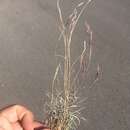Comprehensive Description
(
Anglèis
)
fornì da North American Flora
Bouteloua trifida Thurber, in S. Wats. Proc. Am. Acad 18: 177. 1883.
Bouteloua Burkii Scribn., in S.Wats. Proc. Am. Acad. 18: 179. 1883. (Type from Laredo, Texas,
Berlandier 1427.) Chondrosium Trinii Foum. Mex. PI. Gram. 2; 136. 1886. (Type from Laredo, Texas, Berlandier
1427.) Chondrosium Virlelii Fourn. Mex. PI. Gram. 2: 136. 1886. (Type from San Luis Potosf, Mexico,
Virlet 1373.) Bouteloua trifida var. Burkii Vasey; L. Dewey, Contr. U. S. Nat. Herb. 2: 532. 1894. (Based on
B. Burkii Scribn.) Bouteloua Trinii D. Griff. Contr. U. S. Nat. Herb. 14: 387. 1912. (Based on Chondrosium Trinii
Foum.)
Perennial; culms densely tufted, erect, 10-35 cm. (mostly about 20 cm.) tall, scaberulous; sheaths glabrous or scaberulous, the lower ones longer, the upper shorter than the internodes; ligule ciliate, about 0.5 mm. long; blades flat, acute, scabrous, 0.8-5 cm. long, 0.5-1 mm. wide; spikes 3-6, 1-3 cm. long, appressed to spreading; spikelets spreading or nearly appressed; glumes acuminate, glabrous, the first 3.5 mm. long, the second 4.5 mm. long, scarcely broader than the first; body of lemma about 2 mm. long, glabrous, or pubescent toward the base, the 3 slender lobes gradually narrowed into awns, these about 5 mm. long; rudiment cleft to the base, the lobes gradually narrowed into the awns, about as long as those of the fertile lemma.
Type locality: Monclova, Coahuila (Palmer 1355 in 1880).
Distribution: Dry prairies, chaparral, and rocky slopes, western Texas to southwestern Utah, Arizona, and northern Mexico.
- sitassion bibliogràfica
- Albert Spear Hitchcock, Jason Richard Swallen, Agnes Chase. 1939. (POALES); POACEAE (pars). North American flora. vol 17(8). New York Botanical Garden, New York, NY
Physical Description
(
Anglèis
)
fornì da USDA PLANTS text
Perennials, Terrestrial, not aquatic, Rhizomes present, Rhizome short and compact, stems close, Stems nodes swollen or brittle, Stems erect or ascending, Stems geniculate, decumbent, or lax, sometimes rooting at nodes, Stems caespitose, tufted, or clustered, Stems terete, round in cross section, or polygonal, Stem internodes hollow, Stems with inflorescence less than 1 m tall, Stems, culms, or scapes exceeding basal leaves, Leaves mostly basal, below middle o f stem, Leaves conspicuously 2-ranked, distichous, Leaves sheathing at base, Leaf sheath mostly open, or loose, Leaf sheath smooth, glabrous, Leaf sheath hairy at summit, throat, or collar, Leaf sheath and blade differentiated, Leaf blades linear, Leaf blades very narrow or filiform, less than 2 mm wide, Leaf blades mostly flat, Leaf blade margins folded, involute, or conduplicate, Leaf blades mostly glabrous, Leaf blades more or less hairy, Leaf blades scabrous, roughened, or wrinkled, Ligule present, Ligule a fringe of hairs, Inflorescence terminal, Inflorescence with 2 or more spikes, fascicles, glomerules, heads, or clusters per culm, Inflorescence a panicle with narrowly racemose or spicate branches, Inflorescence with 2-10 branches, Inflorescence branches 1-sided, Inflorescence branches terminating in bristle or point, Flowers bisexual, Spikelets sessile or subsessile, Spikelets laterally compressed, Spikelet less than 3 mm wide, Spikelets with 1 fertile floret, Spikel ets solitary at rachis nodes, Spikelets all alike and fertille, Spikelets bisexual, Spikelets disarticulating above the glumes, glumes persistent, Spikelets secund, in rows on one side of rachis, Rachilla or pedicel glabrous, Glumes present, empty bracts, Glumes 2 clearly present, Glumes equal or subequal, Glumes distinctly unequal, Glumes equal to or longer than adjacent lemma, Glume equal to or longer than spikelet, Glumes 1 nerved, Lemma coriaceous, firmer or thicker in texture than the glumes, Lemma 3 nerved, Lemma glabrous, Lemma apex dentate, 3-5 fid, Lemma distinctly awned, more than 2-3 mm, Lemma with 3 awns, Lemma awn less than 1 cm long, Lemma margins thin, lying flat, Lemma straight, Palea present, well developed, Palea membranous, hyaline, Palea shorter than lemma, Palea 2 nerved or 2 keeled, Stamens 3, Styles 2-fid, deeply 2-branched, Stigmas 2, Fruit - caryopsis, Caryopsis ellipsoid, longitudinally grooved, hilum long-linear.
Bouteloua trifida: Brief Summary
(
Anglèis
)
fornì da wikipedia EN
Bouteloua trifida is a species of grass known by the common name red grama. It is native to central and northern Mexico and the Southwestern United States, where it grows in desert scrub and other dry areas.
This is a small perennial grass growing up to about 30 centimeters in maximum height. It occasionally grows a small rhizome. The thready leaves are no more than 5 centimeters long. The inflorescence bears widely spaced spikelets which are reddish purple in color. Each spikelet has three awns at the tip.
Typically it flowers between March and September.
- licensa
- cc-by-sa-3.0
- drit d'autor
- Wikipedia authors and editors

